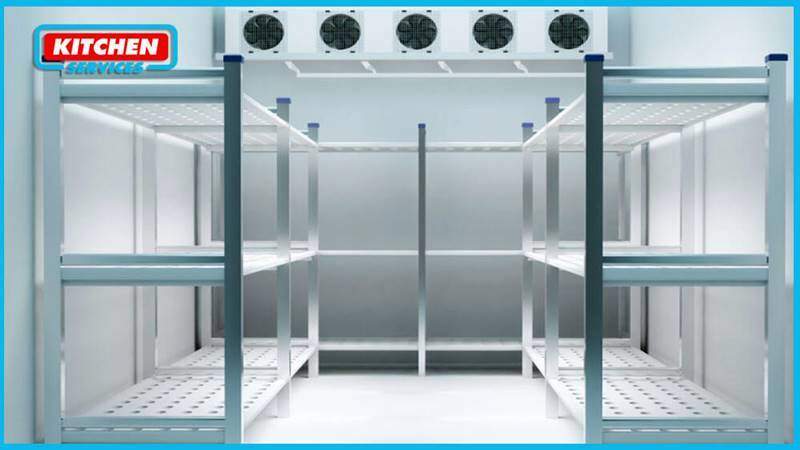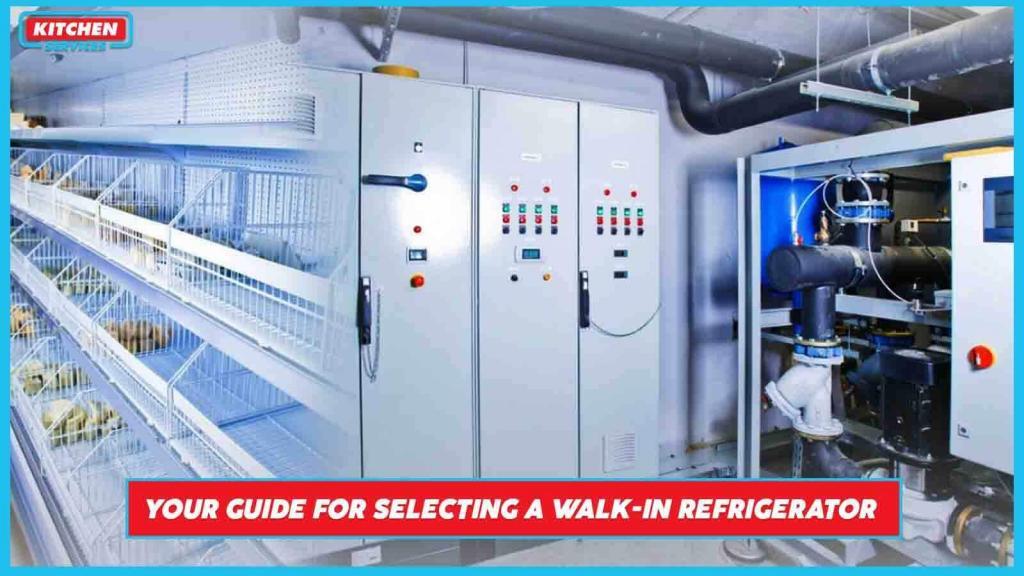Whether it is for commercial purposes or residential, we all are very conscious when it comes to making big investments. Be it due to their giant size, the installation cost, maintenance charges, or energy costs, all reasons require you to do adequate research before you invest in any Walk-In Refrigerator.
This is why Kitchen Services came up with a professional guide for you to make an educated decision. Before replacing or buying a new walk-in refrigerator, you need to know when is the right time to buy a new one.
When Should I Buy a New Walk-In Refrigerator?
Consider these following points before you decide on buying a new walk-in refrigerator.
- Your foodservice business that produces items on a high volume requires a large storage space. This is when you will need a walk-in refrigerator or freezer.
- You will require a commercial walk-in refrigerator or freezer if you are planning on extending your food business by inaugurating new branches.
- If your old walk-in fridge is no longer efficient and does not keep your items fresh then it’s time to move onto a better walk-in refrigerator.

Types of Walk-In Refrigerators
There are two categories of walk-in refrigerators from which you can choose your type.
- Prefabricated Walk-Ins: These kinds of walk-ins are made from pre-made urethane. They come in set layouts and sizes. Below we have mentioned some benefits of prefabricated walk-ins.
- This type is not that expensive.
- You can change the configuration depending on your business needs.
It is only fair to look at the drawbacks of prefabricated walk-ins as well
- They come in limited sizes.
- They are not as long-lasting as the other type (built-in unit).
- Built-In Walk-Ins: Built-in walk-in refrigerator is designed with walls that are heavily insulated. They have got structural tiles that cover the floor and the walls. Let’s shed some light on the pros of Built-in walk-ins.
- They come in unlimited sizes for you to choose from.
- You can customize one according to your needs and design.
The cons of these Built-ins are:
- They are expensive to design.
- They are not as easily expanded after completion as you would wish for your business needs.
These all above-mentioned points are important for a person who wants to buy a walk-in refrigerator. Having enough knowledge and in-depth information will assist him in making a sensible choice when it comes to cooling appliances.
After selecting a type that fits your needs, you should consider the following points when buying a new walk-in refrigerator.
Storage Space
When it comes to storage space, for restaurant owners it is always better to have too much area of space than having insufficient space. For instance, if you are running a restaurant or any other business that requires a commercial walk-in refrigerator, you will need around 1.5 cubic feet of storage space. Hence, considering the storage capacity before buying is one of the most important things that matter.
Type of Food to Store
The next thing you should consider is the “type” of food you will be storing in your walk-in fridge. Keep in mind that the refrigerators have a temperature range that goes from 35° F to 41° F. They are able to keep things very cold but not frozen.
For instance, you can use a walk-in refrigerator to keep desserts, ready-to-make food items, yogurt, milk, drinks, etc. type items in it. However, if you want to store things like raw meat or frozen items, then a walk-in freezer is the right option for you.
Refrigeration System
Before buying a walk-in refrigerator, it is important for you to study the refrigeration system you have, in detail. For example, there are remote refrigeration systems. These are usually located outdoors while your walk-in fridge is installed indoors.
This can be a good option for those who don’t want extra noise and heat around their walk-ins. There are different purposes and benefits of different refrigeration systems.
Where to Install
Installation of a walk-in refrigerator or freezer is not an easy task. It causes a lot of disturbance. There are two options of installations you can avail of when it comes to walk-in refrigerators.
- Indoor Installation: Indoor installation is not always a good idea. To get indoor installation, you should know that they are going to occupy a lot of your space in the kitchen. Depending on your interior space and size, your options for refrigerators become limited as well.
If your restaurant is located in a hot and humid environment, then don’t opt for indoor installation. It will add extra heat and humidity to your sitting area and kitchen, making it unpleasant and uncomfortable.
- Outdoor Installation: Outdoor installation will save you from all the above-mentioned problems. However, when installing your walk-in refrigerator outdoors, there are a few things to consider. Your walk-in should be able to bear the sunlight, rain, or occasional winds.
Energy Consumption
Big appliances come with a price i.e. the electricity bills. If you are choosing a large unit, then you should keep in mind that it will require a large compressor. Consequently, heavy electricity bills.
To save your money, what you can do is that you can opt for polyurethane insulation, with high density that can be proven to be energy efficient. Ensure that the ceiling, walls, and flooring of your walk-in are insulated. This will prevent leakages. Hence, resulting in less energy consumption.
How to choose a Walk in Refrigerator?
You should keep these things in mind while choosing a commercial Walk in Refrigerator
1. Insulation Type
The whole walk-in is heavily insulated starting from its floor to the ceiling. This would make sure that the cold temperatures inside stay the same in order to keep all your food items cool, fresh, and safe to consume. There are many types of insulation material that are used for walk-ins, which are generally classified as per their R-value. This usually refers to the material’s capacity in order to resist heat flow, and how much insulating power it normally has. All the material that has a higher R-value tends to provide better insulation than low R-value materials.
Foamed-In-Place Polyurethane
Foamed-in-place polyurethane is basically sprayed between two metal panels that usually make up the sides and ceilings of these walk-in units. This has an R-value of R8 per square inch, which makes it the most efficient insulation among the most common materials that are available. It is also exceptionally moist as well as fire-resistant and has a high melting point of 700° F. The end result is quite powerful insulation that makes sure the cold air inside your walk-in is perfectly sealed in.
Extruded Polystyrene (XEPS)
XEPS has an R-value of R2 to R5, that is lower than that of foamed-in-place polyurethane. Polystyrene insulated units are produced by simply laminating (gluing) the outer metal skin onto foam blocks which have been known to break after some time. No doubt It is pocket friendly but the decrease in efficiency would mean your walk-in refrigerator will need to work a lot harder and consume more energy in the long run.
Laminated Panels
This type of insulation usually uses polyurethane slabs that are glued to the insides of the unit’s panels. The drawback of using laminated panels is that there might be a tendency for the insulation material to peel off from the metal panels.
2. Flooring
Insulating the floor can be very critical in case you plan to install your walk-in in any of your basement. Floor insulation will always protect your walk-in from the heat circulating directly below the walk-in. The ideal setup to install your walk-in is to have an insulated floor that has quarry tile and grout that is installed above an insulated concrete slab and topped with a thermal break. Concrete does not provide sufficient insulation by itself; it must be insulated to make sure that the interior reaches temperatures below 37° F and maintains that.
You might find it attractive to get a walk-in that has no floor, and you can easily have it installed over a finished floor because of the less expenses. But instead, the cost of utilities would take you to the same position where you already were. The fact is that when you are purchasing a walk-in freezer, an insulated floor is an absolute necessity due to extremely low temperatures which can crack the floor. Having a properly insulated floor allows you to cut back on your energy costs by around 15%.
3. Finishes
Galvalume
Galvalume is actually a galvanized steel which is coated with a layer of aluminum. You may find it the most common finish for all your walk-ins due to the reason that it is not as prone to rusting and corrosion as plain galvanized steel would be. It is also stronger, more durable, and more dent resistant as compared to aluminum. Galvalume usually comes with a minimum thickness of 26 gauge.
Galvanized steel
As said earlier galvanized steel is not as durable as galvalume and it can be prone to rust as soon as it gets exposed to moisture. The minimum galvanizing for walk-in refrigerators and freezers is G90, which is stronger and more dent-resistant than aluminum. Galvanized steel usually has a minimum thickness of 26 gauge for walls and ceilings and 16 to 20 gauge for floors.
Painted Galvanized
Painted galvanized will basically cost you more than galvalume, but it is also more corrosion-resistant due to the fact that it has an extra coat of paint which will add protection against rusting. It also allows you to customize your unit so that you can have different color options.
Aluminum
as we know that aluminum is not as corrosion resistant as other materials usually are. Also it would need to be thicker in order to provide sufficient strength. It has to be 40 mm to 60 mm in thickness for the walls and ceilings and 100 to 120 mm for the floor. Some of the walk-ins have 1/8” aluminum floors with diamond tread-plate embossing to add extra strength.
Stainless Steel
Stainless steel is considered as the strongest and least corrosive of all finishing materials, which makes it suitable for all those areas that have high foot traffic. It is also very expensive.
4. Assembly
Pre-assembled
There is an option for a pre-assembled walk-in unit that would arrive on-site on a truck. It depends on the size of the unit, you can lift it out of the truck with the help of a crane. Delivery and installation of pre-assembled walk-in can cause a lot of interruption to your functions. So, it would be the best option to have a pre-assembled unit delivered during slow days or if your establishment is still being constructed.
Assembled On-Site
Well, on-site assembly is very much expensive, but you might need it if the size of walk-in that you need to make sure smooth operations does not fit through the doors of your kitchen or industry. This type of assembly is the best for restaurants that need large walk-ins to store their refrigerated items.
5. Refrigeration System
Walk-ins are widely available with split systems and self-contained refrigeration systems.
Split System
Split systems are generally the remote refrigeration systems in which the condensing unit is basically installed on the roof of the walk-in box, which is a separate room, or it may be on outside the building, usually on the rooftop. It will allow heat to stay outside so that it does not heat up the entire kitchen.
Self-Contained System
Self-contained systems come with their components, refrigeration lines, and drainage systems that are already installed. Actually you will not need a technician to install this kind of refrigeration system, rather you will only have to lift it to the top and bolt into place, making installation so much simpler.
Capsule packs also come in side-mount self-contained configurations for those areas that have low ceilings. The evaporator coil in this kind of system takes a bit of interior space, but it won’t be as severe as the conventional side-mounted units normally are. Nothing like drop-ins, however, side-mount capsule packs might have to be hardwired by a certified technician.
Always remember that a capsule pack would need room and that depending on the size, you will have to dedicate around 2′ x 3′ with some extra breathing space around the system in order to ensure good ventilation.
6. Door
As we know that the door of a walk in is the most important and useful part of the whole system. Obviously, it is the door that would provide access to enter to the whole staff meanwhile it would help in preventing the cold air inside from leaking towards the outside. Consequently, the walk-in’s door must be built to be able to withstand repeated use. A sturdy door must have a stainless-steel front and a kick plate so that it can absorb some of the impacts the door has to encounter. It will also protect the door from getting any scratches, chipping, or denting.
Strong and sturdy door frames as well as heavy-duty or industry-grade hinges and latches will provide highest durability. Whereas loose hinges have the tendency to create air gaps that will allow hot air to seep inside and compromise energy productivity. These doors should also have well-fitting gaskets so that they can prevent cold air from leaking out in any way.
You must look for a walk-in refrigerator or freezer that has self-closing doors to make sure that the doors are always closed even if there is nobody to close them. There are some doors that also have a small glass window which will allow the faculty to see inside and decide what they want without having to open the door again and again. Another feature that you may want to invest in is a door lock so that you can have an extra layer of protection for your food stocks during after-hours.

